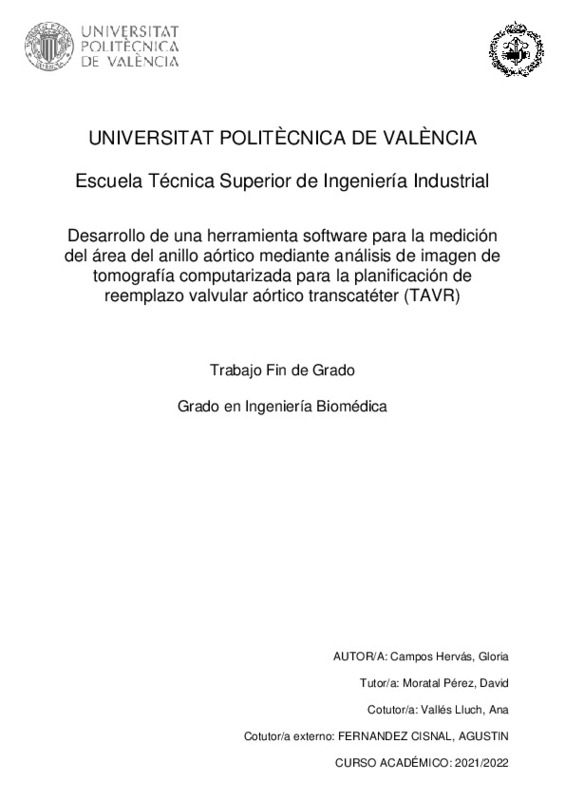|
Resumen:
|
[ES] La estenosis aórtica es la valvulopatía más frecuente. Clásicamente, en casos severos y con
sintomatología, el tratamiento indicado es el reemplazo valvular mediante abordaje quirúrgico.
Sin embargo, en las últimas ...[+]
[ES] La estenosis aórtica es la valvulopatía más frecuente. Clásicamente, en casos severos y con
sintomatología, el tratamiento indicado es el reemplazo valvular mediante abordaje quirúrgico.
Sin embargo, en las últimas décadas, se han desarrollado técnicas percutáneas con la finalidad de
evitar abordajes invasivos y sus derivadas complicaciones. El reemplazo valvular aórtico
transcatéter (TAVR, por sus siglas en inglés) permite realizar dicho procedimiento sin necesidad
de intervención quirúrgica, y se considera de elección en pacientes de alto y moderado riesgo
quirúrgico, así como una alternativa en aquellos pacientes con bajo riesgo.
El remplazo de la válvula aórtica transcatéter requiere de una cuidadosa planificación previa para
determinar las características anatómicas del paciente y los requerimientos que debe cumplir la
prótesis para ser implantada con éxito. La estructura más importante a analizar es el anillo aórtico,
pues es donde va a ser asentada la prótesis, por lo que resulta crucial obtener distintas
características de la aorta en base a su área y diámetro.
Por ello, este proyecto aborda el desarrollo y programación de una aplicación que permita obtener
distintas mediciones relacionadas con el área del anillo aórtico para escoger el tamaño adecuado
de la prótesis a ser implantada. Utiliza la herramienta de programación App Designer de Matlab
con el fin de determinar las particularidades de la aorta sobre la que se pretende intervenir
mediante el análisis 2D de imágenes de tomografía computarizada (TC). Adicionalmente, se han
empleado diversos softwares para un análisis previo y, posteriormente, comparación con los
resultados que proporcionan dichas herramientas utilizadas hoy en día en la práctica clínica.
[-]
[EN] The aortic stenosis is the most frequent heart valve disease. In severe cases with symptomatology the indicated treatment is the valvular replacement. Conventionally, the aortic valvular replacement is performed by ...[+]
[EN] The aortic stenosis is the most frequent heart valve disease. In severe cases with symptomatology the indicated treatment is the valvular replacement. Conventionally, the aortic valvular replacement is performed by surgical approach; nevertheless, in the last few decades, percutaneous techniques had been developed in order to avoid invasive procedures and their derived complications. The transcatheter aortic valve replacement (TAVR) allows to perform the procedure without the necessity of surgical intervention and it is considered as an election for high and medium risk patients, and an alternative in those who have low risk.
The transcatheter aortic valve replacement requires a careful previous planification to determine the anatomic characteristics of the patient and the requirements the prothesis has to fulfil to be successfully implanted. The most important structure to analyse is the aortic ring, as this is the location where the prothesis is going to be settled, and that¿s why it¿s crucial to obtain different characteristics of the aorta derived from the area and diameter.
This final project will be focussed on developing and programming a software to obtain different measurements in relation with the aortic ring¿s area to choose the adequate size of the prothesis that will be implanted. It will be based on a 2D analysis which will include the use of computed tomography images (CT) to determinate the peculiarities of the target aorta. Additionally, the procedures that have been followed in other software tools as a guide for the design of the app will be exposed, just as an exhaustive analysis to compare the obtained results with the ones that are given by professional softwares used in the clinical practice.
The objective of this final project, which will be developed in close collaboration with the Interventional Cardiology Unit from the Hospital Clínico Universitario of Valencia will be the development of a software tool for the measurement of the aortic ring¿s diameter during the aortic stenosis treatment by means of CT image analysis. Furthermore, it includes the evaluation of the developed method and the possible impact it may have in the real clinical practice.
The code will be written in Matlab, specifically in App Designer (interactive development environment). Thus, it will be possible not only to obtain a code to perform the adequate functions, but also an executable app to allow a more intuitive interaction with the machine. Furthermore, the free software 3D Slicer will be used as a guide for the planification of the steps that must be followed in the program¿s development.
[-]
|







